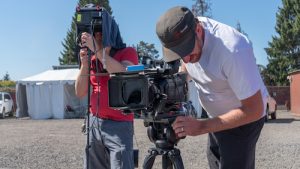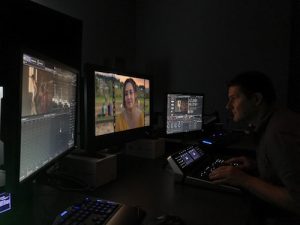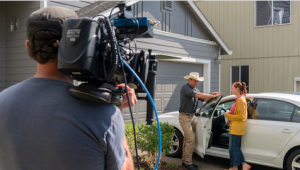
DP Michael Ferry shoots with a Blackmagic URSA Mini 4.6K while Colorist Mark Todd Osborne used DaVinci Resolve Studio in post
When her father goes missing during a mountaineering expedition, Lindsey Lou (Jillian Clare) sets out to find him – only, she’s the least qualified candidate to do so. “Pretty Broken” follows Lindsey’s journey as she struggles with the loss of her father, and deals with how life and family can be challenging (and funny). Directed by Brett Eichenberger, the film recently premiered at Newport Beach Film Festival.
Lots of Locations, Little Time
“When we set out to make the movie, we wanted it to have as close to a filmic look as possible,” Eichenberger says. “We knew we could achieve that by shooting with Blackmagic Design cameras and then continuing in post with DaVinci Resolve Studio.”
Eichenberger and DP Michael Ferry decided to use an URSA Mini 4.6K EF as the film’s main camera, along with a Production Camera 4K used for challenging shots that required a two-camera setup.
“We were interested in establishing a style for the film that was gritty at times with the use of natural light and a handheld camera. As the film progresses, the camera settles down and the scenes are more visually stable. We wanted the camera work to represent Lindsey’s psyche as she grows as a person,” Ferry explains.
“The URSA Mini 4.6K’s dynamic range and design allowed us to shoot without a lot of lights or grip equipment. It ultimately allowed us to move faster, more like a documentary crew, which I love as a director because it helps keep the actors in the moment,” continues Eichenberger. “In one 12-hour day, we were able to do five major location moves – and still wrapped early. We could move quickly and make it work because the camera’s dynamic range allowed us to shoot with available light in each of those locations. The simplicity of the menu and camera’s ease-of-use also helped us speed along on set, since it was intuitive, and we didn’t have to waste time.”
“We had a lot of pages to shoot each day, but the camera was so straightforward to work with that we developed a system between myself and the camera department that allowed us to work quickly and move from setup to setup very efficiently,” adds Ferry.
Locations for the film ranged from daytime and nighttime scenes in a house; to some challenging outdoor environments such as a canopy of trees, twilight shots and a forest; and nighttime shots in and out of a car. Due to time constraints, Eichenberger and his team didn’t have time to tech scout most of the locations.
Eichenberger explains, “We shot some test shots at a few of our more challenging locations, but we didn’t have time for the rest. We were never worried about the camera handling what we threw at it though. We were confident we’d get what we wanted with the dynamic range and shooting in RAW. It’s nice to be able to depend on your gear when you’ve got so many other things to be concerned about on a low budget film.”
Shooting in RAW
“The dynamic range of the camera in RAW was such an important tool in this production. For example, we had a number of scenes in the used car lot office which had a couple large windows we had to deal with. Without a bunch of ND on the windows or large units inside giving us illumination, we were able to get a really balanced exposure. We were able to stick to the original intent of using natural light throughout this film to create a very naturalistic look,” Ferry says.
With a lot of the film split between the used car lot where Lindsey and her brother Monty (Preston Bailey) work and the Lou household, Ferry had to deal with the unique challenges that each location had.
“These locations couldn’t have been more different, nor could have the shot structure and shooting environment. The lot was a challenge because we were shooting full days in direct sunlight, which can problematic due to the high contrast nature of the scenes,” explains Ferry. “We used silks and bounce throughout, but the camera’s dynamic range really shined, allowing us to create a beautiful realism to the visuals. In the Lou house we had much more control over lighting and exposure, and again the camera shined. It really is a camera that can perform in any situation.”
“Most of the film is shot with natural light, modified, but still natural,” Ferry continues. “We needed a camera that could give us RAW and had the dynamic range to handle the highlights and the shadows, and give us enough information in post to create an image we were satisfied with. As we tested the CinemaDNG RAW workflow through DaVinci Resolve Studio, we knew the URSA Mini 4.6K could handle the challenge of shooting in some pretty high contrast situations.”
“Shooting in RAW 4:1 made the most sense for the film. Since we shot the film mostly in available light and we were moving fast, we knew we were going to need to be able to tweak with the image on a very flexible scale once we were in post. We didn’t have the time or budget to ND out windows or put up a ton of diffusion. We have many shots where we were able to pull the highlights down in a background window and retain all of that information. Same with shadows,” Eichenberger adds.
Enhancing with Color
Colorist Mark Todd Osborne, owner of MTO Color, Inc., used Blackmagic Design’s DaVinci Resolve Studio and a DaVinci Resolve Mini Panel to grade the film.
“As a colorist, it’s great to work in RAW because it gives you so much control over the image. I like to think of DaVinci Resolve Studio as my new laboratory for processing RAW. You can redesign the image from the ground up. For scenes that need slight tweaking, it’s easy to go in and adjust the structure of the file so we can get the best image out of it.”
To enhance the look that Ferry achieved with the camera, Osborne used DaVinci Resolve Studio to create a natural, neutral look for the first two acts of the film, and then a warmer look for the third act when things are looking up for Lindsey. Osborne then relied on DaVinci Resolve Studio’s grouping feature when designing a look for the film’s flashback sequences.

Colorist Mark Todd Osborne, owner of MTO Color, Inc., used Blackmagic Design’s DaVinci Resolve Studio and a DaVinci Resolve Mini Panel to grade the film.
“We wanted to develop a specific look for the flashbacks that differentiated them from the current day timeline,” Osborne explains. “Using the grouping feature, I could easily grab a group of shots, develop some different looks and then send Eichenberger options of the different flavors. We ended up using the primaries to add some warmth and cyan green and yellow to the shadows, and then the Blur tool to tilt shift the lens to get an otherworldly feel for the flashbacks that draws the audience’s attention to the character’s face.”
Throughout the film, Osborne used DaVinci Resolve Studio’s face tracking and face refinement tools to help beautify skin, and its grain tools to add subtle texture to give the movie the filmic look that Eichenberger wanted. “Ultimately, working with DaVinci Resolve Studio and the DaVinci Resolve Mini Panel allow me to stay in the creative zone. It’s intuitive to how I want to work as a colorist, and that gives me the freedom to stay in my flow and not worry about the technology,” Osborne concludes.
About Pretty Broken
Recently premiering at the Newport Beach Film Festival, “Pretty Broken” tells the story of a college dropout on the verge of divorce who reconnects with her family after her father goes missing in a mountain climbing accident in the Himalayas. Hanging on to a shred of hope that he’s still alive, she hatches a scheme to raise enough money to go to Everest and bring him home herself. The only problem – she’s the least qualified for the job.

